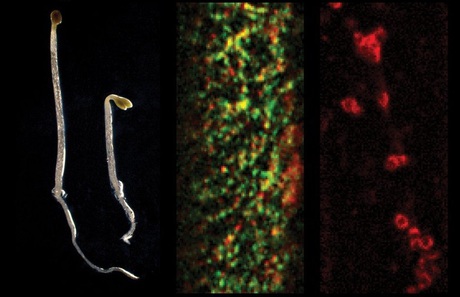How plants cope with a salty environment

It turns out a diet high in salt isn’t just unhealthy for humans, with salty soil being one of the major factors that negatively impacts plant growth. Scientists from the University of Melbourne have recently discovered how plants cope with high salt levels, in research that could potentially lead to the generation of salt-tolerant crops in future.
It is estimated that 20% of the world’s agricultural land is afflicted by high levels of salt — a number which is expected to rise to 50% by 2050. It is therefore of great agricultural importance to find genes and mechanisms that can improve plant growth under such conditions.
“Plants need to make bigger cells, and more of them, if they want to grow and develop,” said Professor Staffan Persson, who led the recent research.
“Unlike animal cells, plant cells are surrounded by a cellular exoskeleton called cell walls, which direct plant growth and protect the plant against diseases.
“Most of the plant’s biomass is made up of the cell wall, with cellulose being the major component. Hence, plant growth largely depends on the ability of plants to produce cell walls and cellulose.”
Previous studies have shown that the cellulose-producing protein complex, called cellulose synthase, interacts with, and is guided by, an intracellular polymer structure called microtubules. This interaction is important for shape and stability of plant cells.
Professor Persson and his team have now identified a previously unknown family of proteins supporting the cellulose synthase machinery under salt stress conditions, which they dubbed ‘companion of cellulose synthase’ proteins. Writing in the journal Cell, the researchers outlined a mechanism for how these proteins help plants to grow and produce their biomass under salt stress conditions.
“We show that these proteins, which we called CC proteins, are part of the cellulose synthase complex during cellulose synthesis,” said Professor Persson.
The researchers discovered that the CC gene activity was increased when plants were exposed to high salt concentrations. They thus hypothesised the involvement of these proteins in salt tolerance of plants.
“To prove this hypothesis, we deleted multiple genes of the CC gene family in the model plant Arabidopsis thaliana (thale cress) and grew the plants on salt-containing media,” said team member and co-first author on the study Christopher Kesten. “These mutated plants performed much worse than the wild-type plants.”
“In an additional step, we made fluorescent versions of the CC proteins and observed, with the help of a special microscope, where and how they function,” added Dr Anne Endler, also co-first author of the study. “It was quite a surprise to see that they were able to maintain the organisation of microtubules under salt stress. This function helped the plants to maintain cellulose synthesis during the stress.”
The research group thus demonstrated that while the control plants could maintain their microtubules intact, the plants lacking the CC activity were unable to do so. This loss in microtubule function led to a failure in maintaining cellulose synthesis, which explained the reduction in plant growth on salt.
The results therefore provide a mechanism for how the CC proteins aid plant biomass production under salt stress, and also provide a series of questions for Professor Persson and his team to tackle in the future.
“For example, how are the CC1 and CC2 proteins binding to the microtubules, and how do they affect the polymerisation of the microtubules?” he said. “And also, can we produce more of the CC proteins in a plant to make them more resistant to salt stress? These questions are something that will lay a platform for our future research.”
Left panel (plants grown on salt): Plants with CC proteins (wildtype, left) grow better on salt containing media than mutant plants (right), missing the CC genes.
Right panel (inside the cell): A view inside the cell under salt stress. Plants with CC proteins (wildtype, left) show functional cellulose synthase complexes in the plasma membrane; plants without CC proteins (mutant, right) show internalised cellulose synthase complexes which are not active anymore.
CC proteins are shown in green; cellulose synthase complexes are shown in red.
European Space Agency inaugurates deep space antenna in WA
The ESA has expanded its capability to communicate with scientific, exploration and space safety...
Black hole collision supports Hawking's landmark theory
Astrophysicists have witnessed a collision between two black holes that was so loud, they were...
Uncovering differences in wild and domesticated crops
Researchers have revealed insights into the genetic make-up of wild varieties of common crops...







